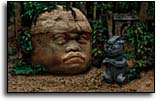
Collect 'Em All
|
The first amazing colossal stone head was found in 1860 in the swamps of the Mexican Gulf Coast. This region would come in time to be known as the Olmec heartland. Since then sixteen more of these monuments of the Olmec civilization have been unearthed.
Your assignment, should you choose to accept it, is to find one that hasn't already been reported by our growing list of contest winners below. And you won't have to fight either mosquitos or torrential rainfall to do it. It's somewhere out there on the Web. Resourceful contestants have already located a bunch of them. The big head they call Monument 1 from La Venta appears to be the most popular photographic subject. (That's probably because it's now located outdoors at a museum park in Villahermosa, Tabasco, Mexico. See below under Heads in the Real World.) We've also found Olmec heads in a few other unexpected places, notably on the Simpsons. ("Didja notice...we never see how they got the huge Olmec head through the tiny front door?") At one time or another our contestants have come across fourteen of the seventeen known noggins: Heads 1-10 of San Lorenzo; Monuments 1, 3 and 4 of La Venta; Monuments A and Q of Tres Zapotes, and Monument 1 from Rancho La Cobata. But even the heads that have been reported keep disappearing again due to the nature of the Web. So you can win a prize by re-discovering a previously reported head that's gone missing. Look under the "headings" below: If there's no link, then that head is fair game for a prize. If the link isn't working, let us know, and you can win a prize for finding a replacement. |
Monument 1, La Venta

|
This great view of Monument 1 at the time of its discovery was sent in by David "Zeb" Cook.
Monument 1 was also submitted by Kendall Kroesen, D. M. Urquidi, Ed Jolie, Emily Gusba, Paul J. McMahon Jr., Scot and Judith Rhoads, Alexander Lucas, Erik Alan Pohl, Richard G. Geordt, Samuel M., Charles W. Achey, Virginia Nott and Marianne Robbins back in the days when we had a big enough supply of prizes to give one out every time someone found a different picture of the same head. (Other views: #1, #2, #3.) |
Monument 2, La Venta

| Susan Morley earned herself a prominent place in the Headhunters Hall of Fame with this sighting of Monument 2. (And the website that it came from has a bunch of great photographs of Olmec monuments.) |
Monument 3, La Venta

| Virginia Nott was the first to submit Monument 3. She was also in on a number of other sightings. |
Monument 4, La Venta
| Eleven-year-old Samantha and her mom Cynthia turned up our first view of Monument 4. |
Head 1, San Lorenzo
|
Susan Roberts scored with four different views of Head 1, San Lorenzo, all on one page, together with an illustration of a colossal head being rafted downriver from the quarry to La Venta. But National Geographic went and removed the page. Can anyone find it again?
Head 1, San Lorenzo was also reported by Virginia Nott, Paul J. McMahon Jr., Martha Hepworth and law professor Fran Ortiz. Only one is still online. |
Head 2, San Lorenzo
| Hayden Jones logged the first sighting of Head 2, but you had to look fast because it is gone now. Ditto the ones reported by Shing Horng Choo and Fred Delventhal. But now to the rescue comes Dana Moot II, who discovered a full selection of Olmec heads including Head 2, San Lorenzo (click "naturalistas"). |
Head 3, San Lorenzo
| Martha Hepworth sent in our first sightings of Head 3 and Head 4 in this side-by-side. (Head 3 is the one on the left.) |
Head 4, San Lorenzo
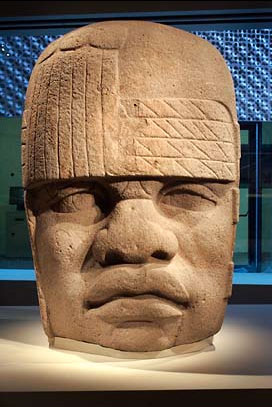
|
We here at "Collect 'em All" were particularly honored when Molly Fierer-Donaldson and Dylan J. Clark of the International Center for Olmec Studies at Harvard's Peabody Museum sent along this sighting of Head 4, temporarily located in our own back yard here in San Francisco. Alas, Head 4 has since gone back to Mexico.
Credit Martha Hepworth for finding a side-by-side of Head 3 and Head 4 on a page that has since disappeared.
|
Head 5, San Lorenzo
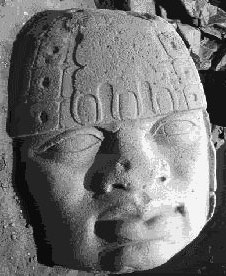
|
This has got to be our favorite so far, for two reasons. First, it has a soundtrack! And second, it's our first sighting of Head 5. To see the Olmec head click the "Table of Contents" link (after the "phat track" music starts playing).
The energetic Fran Ortiz also turned up the same picture of Head 5 on a page with a number of very well photographed Olmec pieces. But alas the page subsequently disappeared. |
Head 6, San Lorenzo
|
Here's Head 6 from Cindy Sweeny. Antje Grüger found another view from the same website. And Carla Flynn found this one on the site of the Splendors of Thirty Centuries exhibition (click the link for "The Olmec Culture").
Head 6 was also featured on the website of Edgar Martin del Campo. He has since replaced it but continues to offer a useful collection of Olmec artworks. |
Head 7, San Lorenzo
| Head 7 was sent in by Jennifer Pepper but was missing in action again until George DeLange came to the rescue. Scroll down to find it on this page which has a lot of great photos from the anthropology museum in Jalapa, Mexico. |
Head 8, San Lorenzo

| Sarah Lindsay Warden Wong collected Head 8 herself in the course of her world travels. She found a replica in Barcelona, in the window of the Barbier-Mueller Museum across the street from the Picasso museum. |
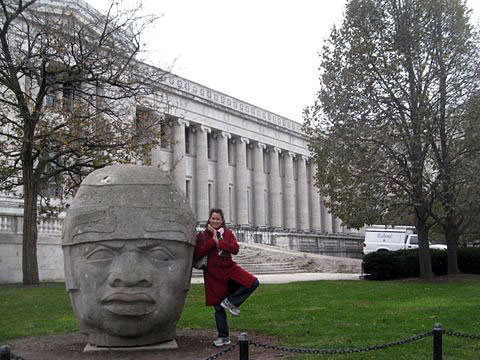
|
And then Sarah Lindsay found another replica of Head 8 in Chicago outside the Field Museum.
Virginia Nott also sent in a neat view of Head 8 (below) from the wonderful 1996 Olmec exhibit in Washington, D.C. (for which they brought a number of colossal heads from Mexico on railroad cars). Lynda Manning-Schwartz also submitted a view of this sculpture, which is also known as San Lorenzo Monument 61. |
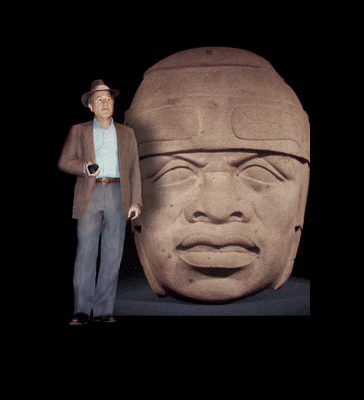
|
And then
Standing next to Head 8 in the photograph above is the man who discovered it, Sheldon Breiner. And we don't mean that he discovered a picture of it on the Web. He actually found the object itself buried underground at San Lorenzo using a magnetometer. You can read all about his amazing life and career in this article:
And here's a link to a scientific report on magnetometer discoveries at San Lorenzo published together with renowed Olmec expert Michael Coe and illustrated with additional photographs including Head 8 still in the ground: |
Head 9, San Lorenzo
| Reinhardt Peters in Germany provided our first sighting of Head 9, but it has since disappeared. |
Head 10, San Lorenzo
| Located in the Tenochtitlán Community Museum in Veracruz and reported by Susan Morley in a photograph taken by the late, great Mayanist Linda Schele. (It's the small photo in the upper right on this page.) |
Monument A, Tres Zapotes
|
This just in from Claudia Aguirre: our first sighting of Monument A... Whoops, you had to look quick. Ron Pistor also submitted a fleeting view. And then, once more to the rescue, comes Dana Moot II with these pics of Monument A.
|
Monument Q, Tres Zapotes
|
Archaeologist Raja Anderson, who worked at the La Venta site in 1988 for the Mexican government, found this view on a page that serves as a tribute to Olmec archaeology pioneer Matthew Sterling. |
Monument 1, Rancho La Cobata
| Alan Pohl enthusiastically submitted a number of heads. Most important is our first reporting of the largest colossal head of them all, Monument 1, Rancho La Cobata. Another view was submitted by Barbara Heyliger. |
Honorable Mention
|
Gail Leonard took time out from her busy duties as Internet maven to send in some interesting links. One helps round out our idea of the Olmecs by depicting twin statues from Loma del Zapote (not far from the San Lorenzo location of Head 8). Kneeling in a posture reflected in other Olmec art, the two figures face a pair of feline statues (not in the photo) in some sort of ritual context. Hero twins figure prominently in the myths of the later Maya culture.
Laura Allen used AltaVista to search for images and submitted a huge collection of heads, including a number that aren't Olmec but make for provocative cross-cultural comparisons. Speaking of which, Glenn Messina has suggested expanding the contest to the Easter Island colossal heads, which, like the colossal heads of the Cham people of Cambodia and our Olmec colossal heads, may arise from a common cultural inspiration. From Carla Flynn, this is not strictly speaking a colossal head, but I can recommend this album by Los Lobos. Linda Weeks and Robyn Davies sent in some thoughts and links having to do with the theory of direct African origins for the colossal heads. Linda came across this interesting comparison of African and Olmec heads. (There is no denying that the colossal heads have facial features that derive from Africa. While it is unlikely that the founders or leaders of Olmec civilization came directly from that continent, their remote ancestors may well have originated there and migrated to Asia, where many original populations of countries like Cambodia and the Philippines have similar characteristics. These might have been brought along when the first humans entered the Americas.) David "Zeb" Cook submitted a photo of Head 1, San Lorenzo on a page with a unique stone bust from the Jalapa museum. Rema Ismail sent in a sculpture of an "Olmec Colossal Head" that you can buy for yourself. They're saying it's from La Venta, but it looks like it's based on Head 1, San Lorenzo.
Justin Kerr's remarkable photographic portfolio contains at least one colossal head — Head 1, San Lorenzo from the Jalapa museum — as discovered by Dana Moot II. To see a wonderful assortment of Olmec artworks, you'll need to click A Precolumbian Portfolio and then the link for "Olmec".
There is a small museum at the archaeological site of La Venta, Tabasco. But because the area was taken over by the oil industry, the colossal heads were moved. As noted above, Monuments 1, 3 and 4 are now located in Villahermosa, Tabasco, Mexico, in the pleasant Parque La Venta. Other heads are located in the Carlos Pellicer Regional Museum of Anthropology also in Villahermosa. Still others can be found in the Tres Zapotes Community Museum, the Santiago Tuxtla Museum, the Tenochtitlan Community Museum and the Jalapa (Xalapa) Museum of Anthropology, all in Veracruz, as well as the National Museum of Anthropology in Mexico City. |